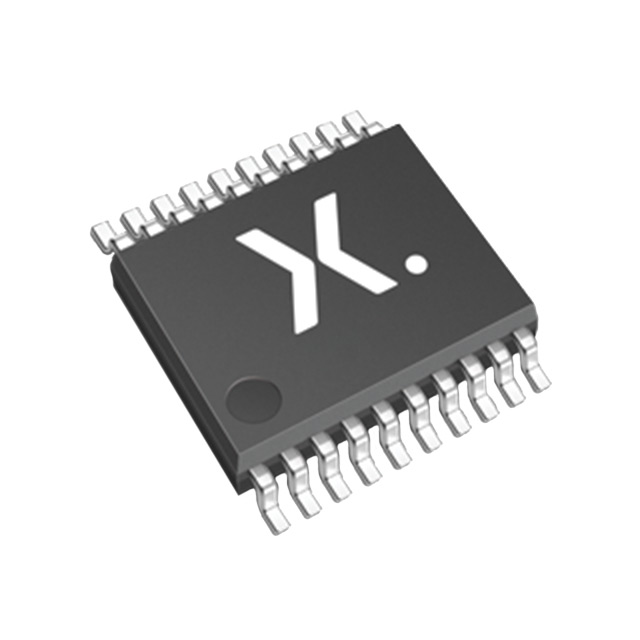Lihat spesifikasi untuk detail produk.

Encyclopedia Entry: 74ALVC245PW,118
Product Overview
Category
The 74ALVC245PW,118 belongs to the category of integrated circuits (ICs) and specifically falls under the family of bus transceivers.
Use
This product is primarily used for bidirectional level shifting and voltage translation between different logic levels in digital systems. It enables seamless communication between devices operating at different voltage levels.
Characteristics
- Bidirectional data transfer capability
- Wide voltage range compatibility
- High-speed operation
- Low power consumption
- ESD protection
- RoHS compliant
Package
The 74ALVC245PW,118 is available in a TSSOP (Thin Shrink Small Outline Package) package. This package offers a compact size and allows for easy integration into various electronic designs.
Essence
The essence of the 74ALVC245PW,118 lies in its ability to facilitate efficient and reliable data transfer between devices operating at different voltage levels, ensuring seamless communication within digital systems.
Packaging/Quantity
The 74ALVC245PW,118 is typically packaged in reels or tubes, with a quantity of 2500 units per reel/tube.
Specifications
- Supply Voltage Range: 1.2V to 3.6V
- Logic Family: ALVC
- Number of Channels: 8
- Input/Output Compatibility: TTL, CMOS
- Operating Temperature Range: -40°C to +85°C
- Propagation Delay: 4.5ns (max)
- Output Drive Capability: ±24mA
Detailed Pin Configuration
The 74ALVC245PW,118 features a dual-in-line pin configuration with a total of 20 pins. The pinout is as follows:
- OE (Output Enable)
- A1 (Data Input/Output)
- B1 (Data Input/Output)
- A2 (Data Input/Output)
- B2 (Data Input/Output)
- A3 (Data Input/Output)
- B3 (Data Input/Output)
- GND (Ground)
- B4 (Data Input/Output)
- A4 (Data Input/Output)
- B5 (Data Input/Output)
- A5 (Data Input/Output)
- B6 (Data Input/Output)
- A6 (Data Input/Output)
- B7 (Data Input/Output)
- A7 (Data Input/Output)
- VCC (Supply Voltage)
- DIR (Direction Control)
- B0 (Data Input/Output)
- A0 (Data Input/Output)
Functional Features
- Bidirectional data transfer: Allows for seamless communication between devices operating at different voltage levels.
- Output enable control: Enables or disables the data output, providing flexibility in system design.
- Direction control: Determines the direction of data flow, allowing for versatile data transmission.
Advantages and Disadvantages
Advantages
- Wide voltage range compatibility enables integration into various digital systems.
- High-speed operation facilitates efficient data transfer.
- Low power consumption contributes to energy-efficient designs.
- ESD protection ensures robustness against electrostatic discharge.
- RoHS compliance promotes environmental sustainability.
Disadvantages
- Limited number of channels may restrict its application in complex systems requiring a higher channel count.
- Propagation delay may introduce timing constraints in certain applications.
Working Principles
The 74ALVC245PW,118 operates based on the principles of voltage level shifting and bidirectional data transfer. It utilizes internal circuitry to convert logic signals from one voltage level to another, enabling seamless communication between devices with different voltage requirements. The direction control pin determines the data flow direction, while the output enable pin enables or disables the data output.
Detailed Application Field Plans
The 74ALVC245PW,118 finds applications in various digital systems where bidirectional level shifting and voltage translation are required. Some specific application fields include:
- Microcontroller interfacing: Facilitating communication between microcontrollers operating at different voltage levels.
- Sensor networks: Enabling data exchange between sensors and control units with varying voltage requirements.
- Communication systems: Supporting voltage translation between different communication protocols and standards.
- Industrial automation: Integrating devices with different logic levels in industrial control systems.
Detailed and Complete Alternative Models
- SN74LVC245APW: Similar functionality and specifications, available in a TSSOP package.
- MC74LVX245DTR2G: Bidirectional bus transceiver with comparable characteristics, offered in a TSSOP package.
- CD74HCT245E: Octal bus transceiver with TTL compatibility, available in a DIP package.
These alternative models provide similar functionality and can be considered as substitutes for the 74ALVC245PW,118 based on specific design
Sebutkan 10 pertanyaan dan jawaban umum terkait penerapan 74ALVC245PW,118 dalam solusi teknis
Sure! Here are 10 common questions and answers related to the application of 74ALVC245PW,118:
Q: What is the function of the 74ALVC245PW,118? A: The 74ALVC245PW,118 is an octal bus transceiver with 3-state outputs. It allows bidirectional transfer of data between different voltage levels.
Q: What is the operating voltage range for the 74ALVC245PW,118? A: The 74ALVC245PW,118 operates within a voltage range of 1.65V to 3.6V.
Q: Can the 74ALVC245PW,118 be used in both 5V and 3.3V systems? A: Yes, the 74ALVC245PW,118 is compatible with both 5V and 3.3V systems, making it suitable for level shifting applications.
Q: How many data lines can the 74ALVC245PW,118 handle? A: The 74ALVC245PW,118 can handle 8 bidirectional data lines.
Q: Does the 74ALVC245PW,118 have any built-in protection features? A: Yes, the 74ALVC245PW,118 has built-in ESD protection on all inputs and outputs, ensuring robustness against electrostatic discharge.
Q: What is the maximum data transfer rate supported by the 74ALVC245PW,118? A: The 74ALVC245PW,118 supports high-speed data transfer rates up to 400 Mbps.
Q: Can the 74ALVC245PW,118 be used in applications requiring hot swapping? A: Yes, the 74ALVC245PW,118 supports hot swapping, allowing for easy insertion and removal of the device while the system is powered.
Q: Does the 74ALVC245PW,118 have any power-saving features? A: Yes, the 74ALVC245PW,118 has a low-power mode that reduces power consumption when the device is not actively transferring data.
Q: Can the 74ALVC245PW,118 be used in automotive applications? A: Yes, the 74ALVC245PW,118 is AEC-Q100 qualified, making it suitable for automotive applications that require high reliability.
Q: What package options are available for the 74ALVC245PW,118? A: The 74ALVC245PW,118 is available in various package options, including TSSOP, SSOP, and DHVQFN, providing flexibility for different PCB layouts and space constraints.
Please note that the specific details and answers may vary depending on the manufacturer's datasheet and application requirements.

